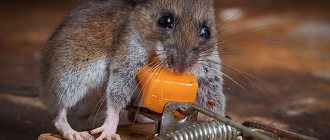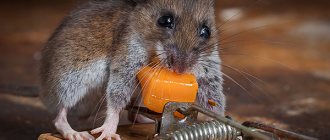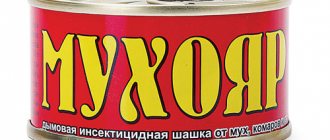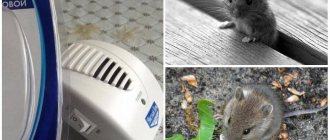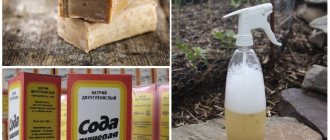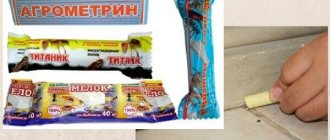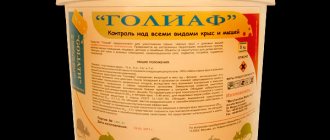In our rat treatments, we use 34 different products, and at most facilities we use a complex of 3-4 drugs and devices. Moreover, what works well in one room or area may turn out to be completely ineffective in another. Therefore, at each specific facility, we select one main anti-rat remedy, and two or three auxiliary ones, and sometimes we find that those same auxiliary ones actually work better and kill more rodents.
Rat in the simplest rat trap
Consequently, there is no universal remedy that is effective and safe always and everywhere. Especially if you need to destroy both rats and mice at the same time. You should always choose either a product or a device based on the conditions in a particular room.
However, it is precisely this arsenal that we have collected that allows us to choose the best rat repellent for a particular object and remove these pests in almost all situations.
Therefore, we will now describe our entire arsenal, dividing the funds from it into groups according to their types and principle of action. For each group, we will indicate the properties, advantages, disadvantages (including implicit ones discovered during application), and say in what cases we use these means. Let's go in order.
All means effective in killing rats
In general, there are a huge variety of effective means, and even more so, methods for exterminating rats. But here we will focus on those that are available to most people, both in purchase and in use. And we will indicate only some of them as used professionally, but not used by the population independently at home. In general, rat killers include:
- Poisoned baits - grain, briquettes, homemade poisons
- Mechanical traps, usually crushers, less often live traps, loops, tops, and others
- Glue traps
- Foam for blocking burrows
- Electrical traps
- Powders for burrow pollination
- Gases for aeration of premises
Gasification of bunkers at the elevator complex
We do not include ultrasonic and electromagnetic repellers as such means, since we have never heard of such devices successfully removing rats. We will also not list here some folk remedies and methods that, on the one hand, do not have a clear principle of action, and on the other hand, are absolutely inhumane.
For example…
We were told about “old-fashioned”, sometimes truly creepy, ways to get rid of rats. For example, a neighbor of a client in Ivanteevka catches a rat with a live trap, then nails it alive to the wall of the barn, or to a board, which he places in the garden. He believes that the animal will scare away other rodents with its dying cries. Another client had the corpses of captured rats scattered in the barn, in the basement of the house and even in the summer kitchen - he believed that the living would avoid these carcasses when gathering. But something went wrong: they still had to call a disinfectant to poison the rats...
It is clear why we are not talking here about cats, weasels, mongooses and snakes, which can catch rats and are sometimes used to protect premises from rodents: you can’t just take the same cat, force it to catch rats, and then throw it out into the street.
Moreover, the means presented in the list above are quite sufficient to remove rats from absolutely any territory or room. If you choose the most suitable ones from these means and apply them correctly, the extermination of rats will be just a matter of time, usually short, within 2-3 days. So let's take a closer look at each category.
Summary
To summarize, we note that there is no ideal method of getting rid of rodents that would suit everyone. OZDS guarantees complete disposal, but it is not profitable to equip an apartment or cottage with it; such a system will be effective in a large facility where the rodent population is large.
Treatment with poisons is cheap and accessible, but dangerous for both humans and animals that live nearby. Therefore, it is better to pay a little more and install several ultrasonic repellers. Well, if there are not so many rodents, then you can get by with a mechanical or electronic mousetrap.
Poisoned baits
According to our statistics, these are the most effective means, although not the most effective in their action. We can definitely say that poisons kill several thousand rats every day in Moscow and the Moscow region alone, and on peak summer days, during the most active breeding season of rodents, the number can reach hundreds of thousands.
All those rodents that you find in yards, in front gardens, along roads, die precisely from poisons, and the vast majority of them - precisely from poisoned baits, since poisons in other forms are much less common.
In addition to their effectiveness, poisoned baits are good for their ease of use and low price. All you have to do to apply them is simply lay them out or scatter them where rats are most likely to find them. At the same time, the most inexpensive of these products can be bought literally for pennies: the same Rat Death in a 100-gram package costs 54 rubles. This amount is enough to bait rodents in a 4-5-room private house.
p>The downside of poisons is the danger for domestic and (sometimes this is important) wild animals. Moreover, the danger can be both direct, when a cat or dog finds the bait itself, and indirect, when the same pet finds a dead poisoned rat. These poisons affect cats and dogs in the same way as they do rats, and may well lead to their death.
The same poisons are dangerous for wild animals, for example, in the vicinity of enterprises where rat control is carried out. Lures can be found by weasels, ferrets, hedgehogs, raccoon dogs, badgers, owls and falcons - those animals and birds that, by the way, very actively hunt rodents themselves and participate in their destruction. And if they find dead or dying poisoned rats, they will also die.
In many cases, this problem is solved by placing baits in special containers called bait stations. The entrances to these containers are made in such a way that a large animal the size of a cat cannot enter them, and at least at home, this is a way to protect pets. However, this method of protection is not absolutely reliable: poisoned rats can still die in almost any place, and cats and dogs can catch them when they are still alive, but less mobile.
Therefore, where the risk of poisoning non-target animals is real, poisoned baits should not be used.
A similar problem: a poisoned rat can crawl in agony into a very hard-to-reach place, die there and begin to stink throughout the entire room. Sometimes, to find and remove such cadaver, it is necessary to move entire offices remotely, open plasterboard walls, remove ceilings, or comb through ventilation.
On a note
Mummifying rat poisons are nothing more than a beautiful advertising hoax. Today, there are no known methods for such mummification with quantities of rodenticide that a rat can eat, nor evidence for claims about the mummifying properties of certain products. In the best case, the rat will die and stink in a place where it will not cause any inconvenience to anyone (for example, in its hole outside the building); in the worst case, it will require repairs with additional deodorization.
Another disadvantage of poisons is the difficulty of monitoring their effectiveness, and with it the difficulty of optimizing their use. We partially solve this problem at large enterprises, where rats constantly appear, coming from surrounding areas, and where we work regularly under contract. Here we can conduct our own mini-research and control the number of rodents, and therefore we see how their number at the site depends on the use of certain poisons, on the different placement of these poisons and on the combination of baits with other means.
Where such controls cannot be carried out, it is difficult to unambiguously assess the effectiveness of the use of baits.
In any case, in a private house, in a garden, or in a chicken coop, this is not a problem - here it will be almost immediately clear whether the poison worked or not. Difficulties arise at large facilities without regular maintenance, where there are a lot of rats and it is impossible to take into account their number, much less fluctuations in these numbers.
Poisoned baits can be purchased, or you can make them yourself. For home use, it is more rational to use store-bought ones: it is simpler and more effective. Effective poisons include:
- Goliath
- Rat death
- Storm
- Three Cats
- Efa
- Nutcracker
- Ratron
You need to prepare poisons yourself against rats that no longer eat industrial designs. We at SanMariDez, for example, have to use our homemade poisons at approximately every fourth site. For such poisons, we use a rodenticidal base with a powerful poison of the latest generation, and effective flavors. Baits used for preparing fishing boilies are most suitable as such flavoring agents.
Our homemade poisons
In general, we poison approximately 85% of the rats at our facilities. Although it is these poisoned rats that are least visible and it seems that other means work more effectively. As a rule, we use such baits at industrial facilities in very large premises, in extensive utility networks (sewage, ventilation, storm drains) and in open areas.
Prevention of mice or how to prevent mice from invading your home?
In general, all of the following preventive measures and tips can be applied to any rodents that may appear in your home. Except that you will have to be even more careful and attentive - after all, mice are very small. So:
- Clean up your yard and home regularly Eliminate any extraneous sources of standing water or cover them thoroughly to prevent mice from reaching them. Throw away trash - mice can use paper, cotton wool, pieces of cloth, etc. to build a nest. They can also settle for the birth of offspring in abandoned furniture - chests of drawers and cabinets.
- A separate item is warehouses with provisions. Every inch should also be inspected there, especially in the autumn-winter period, when the mice are hungry and are looking for new sources of food.
- Cat . Yes, this is not always effective, but good cat-mousetraps do a great job, freeing you from using third-party devices.
- Before the “mouse” season (autumn-winter), walk around your territory and make sure that there are no mouse holes or nests in the grass and bushes nearby. This simple measure will partially protect you from enemy attacks.
- Inspect all walls (inside and outside the house) for cracks, as well as floors, and completely - garages, attics and basements. Do you remember that mice can fit through a hole as thick as a pencil?! Seal all holes, no matter how small, with concrete, sheet metal, or barriers such as copper mesh.
Mechanical traps
These products are simple, cheap, effective, but very troublesome to work with and do not provide such massive destruction of rats as poisons can boast.
The most primitive and simple trap kills one rat and after that requires recharging - until the dead rodent is pulled out of it, it will not kill a new one. As a result, it is extremely difficult for them to catch a hundred or a thousand rats, which means that this is a remedy for a small room, including at home, including in a country house, in a basement, or in a barn.
The advantage of such traps is the controllability of their work. It is quite obvious from the trap whether it worked or not, whether it killed the rat. Moreover, if a rat lives alone in a certain room, a trap is enough to solve the problem with one trigger.
There are trap options designed to catch and kill several rats in a row. Such structures include homemade traps - buckets and boxes with tilting bridges, into which many rats can fall without reloading. But they have no talk about scale: at best, such a trap can catch several dozen rodents. Hundreds and thousands of pests will not be caught in it in a short time.
In addition, the traps are quite safe. Even spring squeezers can be made harmless by simply placing them in a cardboard box with a hole that a cat cannot fit through. In modern containers with such crushers, the trap itself is even fenced off with a partition, into which a particularly curious cat cannot even put its paw. And the rat will climb in without any problems.
These same traps are inexpensive. The simplest rat traps cost 100-150 rubles, more technically advanced ones cost up to 500, which is still quite acceptable.
One such trap can serve faithfully for years, killing hundreds of rats during this time.
And one more non-obvious advantage of such devices: a rat killed in a trap will not run away, die or stink somewhere behind the drywall, or in a ventilation duct, from where its mercilessly stinking corpse cannot be pulled out without the need for repairs.
We use such traps in private homes, in the basements of apartment buildings, in offices, and administrative buildings of enterprises. For home use, this is perhaps the best option.
Glue alt
Mouse glue is widely used in rodent control. Has a viscous consistency. Upon contact with the composition, rodents instantly lose the ability to move. One tube is enough to prepare 20 traps. The composition includes polybutylene, polyisobutylene. Average cost – 170 rubles (135 g.)
Advantages of glue trap for mice:
- ease of use;
- affordable price;
- increased security;
- high efficiency.
After gluing (without human intervention), the rodents die within a few days from lack of water, food, and immobilization. The product is safe to use and does not cause interest in animals. No special skills are required to install the trap. Everything is as simple and fast as possible. To attract rodents, it is recommended to place a small piece of food in the center of the trap, which will attract them. Glue is applied to a plastic or cardboard surface in a strip of 1-2 cm. Placed in habitats where mice gather. The trap needs to be updated once every few days.
Arkady
Glue mouse traps really work. I bought a product to treat a private home. I used it together with chemicals, it helped a lot. Really catches mice. They stick to it very firmly. Not a single pest could get out of it. There are cats living in the house; they showed no interest in the trap, which made me very happy. The product is good, working, and most importantly, inexpensive.
Glue traps
These remedies are as effective as they are fraught with trouble for pets. They cannot be called dangerous, since a glue trap will not kill a dog or cat, but if a pet “gets stuck” in the glue on such a device, it will not be able to get out of it on its own, and the owner will have to cut off such a trap with its fur. This is the main restrictive property of such means: they can only be installed where no one will be caught in them, except, in fact, rats and mice. For example, they are never used outdoors, so that birds do not die in them.
Where glue traps can be installed, they work great. Rats and mice climb into them without fear, sometimes they get into them by accident, but once they get there, they can no longer get out of them, and die for a long time and painfully.
Such traps have several advantages over mechanical traps:
- One trap can catch many rats and mice.
- The trap is customizable, that is, if you have special glue, it can be made the size of an A4 sheet, or you can make half the room a trap, or, say, lay a continuous strip along the wall in which rat holes are found.
- There is nothing to break in glue traps, and they stop working only when the glue surface is completely covered by the caught rodents.
- You can use glue to catch all rodents at the same time, and even non-rodents - rats, water rats, mice, weasels, shrews (although catching shrews is a crime against the garden).
- Such traps are cheap and available.
In addition to the inability to use in homes with pets and outdoors, the disadvantages include their inhumaneness: rats and mice die in such traps for several days, and die from dehydration and hunger. Although for many fighters this is a completely insignificant criterion, some will still prefer a trap that will kill the animal without unnecessary suffering. In an apartment or barn, stuck rats are often found when they are still alive, but cannot move on the glue, and they must be killed manually. Often people are not ready to do this and prefer that a trap quickly and bloodlessly solve this problem for them.
Rats in a glue trap
We use glue traps where we work regularly and have the ability to replace them and throw away traps with caught rats. As a rule, we install such products in basements and attics of enterprises and apartment buildings, in rooms and cavities inaccessible to cats, birds and dogs. The most effective of them work where they can be placed right next to the exits of burrows - rodents cannot get around them and stick to them almost immediately.
Of course, when you independently use such traps in your home or office, you need to check them regularly so that the trap that went off a week ago does not waft the mysterious smell of a dead rat throughout all the rooms...
What danger do mice pose to the home and human health?
From his own experience, the author of the article knows that the appearance of mice in the house certainly does not bring any benefit. When you see a fluffy rodent, be prepared for the fact that you will be rustling through garbage bags at night, gnawing at everything paper and, especially, that smells like food. Also, when leaving the bedroom in the morning, you can find a mouse on the kitchen table, carefully licking a teaspoon of jam that had been forgotten on it and had not been washed.
But all this is nonsense compared to what mice threaten your health and the safety of your belongings. So, a mouse invasion can lead to:
- damaged electrical wiring, which can cause a fire;
- chewed furniture;
- the appearance of a characteristic unpleasant odor from mouse excrement.
After mice have tried your food, it becomes a potential source of various infections.
If mice get to food supplies and gnaw, for example, cereals, they will have to be thrown out. In the tested products, rodents leave particles of their saliva, microbes, dirt from their fur and feces. And even heat treatment will not save such food. By eating it, you can become infected:
- tularemia;
- typhus;
- plague;
- salmonellosis;
- bartonellosis, etc.
Publicly available water that mice have tasted is also dangerous and can cause food poisoning and other illnesses.
Foam for blocking burrows
In fact, such foams can be considered a type of poison that rats simply cannot help but eat. If over time they learn to avoid briquettes, pickled grain and crackers, then they are forced to gnaw the frozen foam that clogs their hole in order to get out. And of course, after that they die.
Interestingly, rats often die before they can chew their way out. We believe that this happens when one rodent uses a hole or a network of tunnels - in this case, the holes simply remain blocked and rats are no longer seen in the room.
In general, such foams are very safe, since no one except rats and mice will chew them. Therefore, they can be used in gardens and open areas, as well as in any premises that have earthen floors and holes in them - in basements, in garages without a concrete screed, hangars.
Rat holes that can be sealed in minutes
An important nuance: the foam works most reliably when all exits from one hole are blocked with it. Since rats usually create a whole network of underground tunnels, there can be many such exits, sometimes more than ten. Therefore, to reliably kill rodents with this product, all such exits must be found, which is sometimes difficult.
In our professional practice, we use foams in almost all industrial facilities and in many residential buildings. However, they are almost never the main remedies for rats, but complement others. As a main remedy, foam can be used where there are few rats, and the owners of the site or house can find all the exits of their rat holes.
Electrical traps
One of the most modern, very effective and very expensive means. For them, everything is relevant as for mechanical traps, and their only important advantage is the ability to “store” the corpses of killed rats in a special chamber, due to which such a trap can kill several individuals without checking.
Other small advantages of electric traps are their ease of installation (there is no need to charge the spring mechanism, which, when charged in this way, can “cut” your fingers) and the absence of misfires - if a rat touches the hook with its teeth on which the bait hangs, it will be killed. Moreover, the death of the rodent will come quickly and it will not suffer.
In our opinion, these advantages are not worth the price difference between an electric trap for 1500 rubles and a die for 120 rubles. Moreover, traps that “load” rats into the compartment cost even more - up to 3000-4000 rubles, and most of them need to be plugged into an outlet, which greatly limits their scope of application. That’s why we literally have several of these traps, and we rarely use them.
Case from practice
A clear example of a case where an electric trap was needed is an elite dovecote in the Krasnogorsk region, in which it was necessary to kill a rat, or several rats. Pigeons were worth their weight in gold, they were regularly transported hundreds of kilometers to release and weed out those that did not return home, and rats killed several chicks in their nests every day and even attacked adult birds, chewing off their toes. Here, in the dovecote itself, it was possible to install only mechanical traps in containers and electric traps. In the utility rooms, the disinfector installed glue traps and laid out granules with poison. However, two rats were caught in an electric trap (apparently, they rarely climbed into the back room, and they already knew the mechanical trap and avoided it).
Poison clean house
Mice poisoning is considered one of the effective methods of pest control. Available in granule form. The composition includes brodifacoum, flavorings, food additives. The product attracts rodents; mice cannot pass by it and eat the poison. The average price is from 30 rubles per 100 g bag.
Advantages:
- economical consumption;
- affordable price;
- the result is noticeable after the first treatment4
- no sharp, unpleasant odor;
- ease of use.
Poison for rodents prevents blood clotting. After its absorption, the mouse dies in the first days as a result of internal bleeding, which can be caused by any even minor damage.
To work with poison, you must follow safety precautions. Use gloves. The product should not be used by persons under 18 years of age. The drug should be sprinkled in places where rodents gather, in their habitats, near burrows. It is necessary to check the integrity of the portion daily, updating it until all rodents disappear.
Eugene
Using the “Clean House” poison, we were able to control mice in our dacha in a very short period of time. Before this, I had been fighting them unsuccessfully for several years, but they kept coming back. I've already tried a bunch of remedies, but nothing helped. With this product everything went easily and quickly, I didn’t even expect it. Several months have passed since the treatment and the rodents have not returned. I am very glad. And the best thing is that there is no pungent odor, the processing is very simple and easy.
Powders for burrow pollination
Another original and very effective remedy is powder, which is blown under pressure from a special sprayer into a hole and settles on all its walls, on the ceiling and on the floor. A rat, running through such a pollinated area, stains its fur with powder, and then, at its leisure, licks all this fur and poisons itself.
Rat holes that can be sealed in minutes
The product works very effectively, and its reliability is higher the more powder is blown into each hole and the deeper it penetrates here. Efficiency is increased even more due to the fact that, having stained the fur in the powder, the animal then wipes the fur on the still clean walls in the deeper parts of the hole, and here other rats, including cubs, will be soiled in this powder brought by it.
Such powders are almost ideal for exterminating rats in open areas of large enterprises - they systematically fill holes, the exits of which are then blocked with foam. At home, they can only be used in the absence of pets who can find and eat a poisoned rat, all stained with poison.
How to choose a pest control contractor? What should you pay attention to?
Deratization is a set of organizational, preventive and extermination measures that are carried out by legal enterprises and individuals. The purpose of the procedure is to reduce the number or eliminate rodents and reduce the damage caused by pests to humans and the environment.
It is often impossible to cope with the problem on your own, so business owners and individuals turn to professionals for help.
When choosing, take into account whether the company has:
- guarantees of the effectiveness of the methods used;
- cumulative discounts for regular customers;
- permits for deratization activities;
- certificates for products and chemicals used in work.
Advantages of turning to experts:
- confidence in the effectiveness of the procedure;
- preparation of documentation in accordance with standards;
- no consequences of the operation for warehouse employees.
REFERENCE. Professional pest control services have a special quality certificate confirming the reliability of the company.
Gases for aeration of premises
The gases used for aeration are the strongest, most effective and most dangerous remedy for rats. Treating a room with their help is called aeration, and this method of deratization, with proper preparation, allows you to destroy all the rats in literally an hour and a half. And not only rats - there are no live cockroaches, moths, bedbugs, or even ants left in the treated room, since the gas that fills the house kills all living things that are not protected by respirators.
The essence of such persecution is simple: the room is sealed and filled with poisonous gas. The gas penetrates absolutely into all cracks, cavities and rat holes, leading to poisoning of the rats in them. The room is infused in this way for about a day, then it is ventilated and washed, after which people can return to it.
However, this is simple only in essence. In fact, a huge, sometimes insurmountable difficulty is to really seal the room and prevent the gas from escaping outside. In any room there are always cracks and holes that are difficult to find and even more difficult to cover. Moreover, such holes can be the same rat holes. And the rats themselves, sensing a gas dangerous to them, can get out of the house through their own holes and escape from poisoning on the site, in the fresh air. To prevent this from happening, all the holes need to be found and sealed, but if this can be done, then it is easier, cheaper and safer to blow powder into the holes, foam the exits from them and forget about the rats.
As a result, aeration from rats is carried out extremely rarely : it costs many times more than rodent control by other methods, but at the same time it requires very complex preparation and strict adherence to safety measures. We carry it out when it is critical for clients that the rats are destroyed literally on the day of departure, and the cost and complexity of the work is of secondary importance for them.
These are the means we use in 99% of calls for pest control. In another 2% of situations, other methods can be used, usually improvised - flooding holes, killing with improvised tools, and others. For example, at one of the sites, an exterminator was digging up a rat hole in the garden with a shovel, and the owner’s dachshund caught the rat pups running out of it.
We very often receive questions from readers, or we are asked by phone about the possibility of using other anti-rat remedies and the effectiveness of these remedies. Now let us briefly mention all the means for which we have information.
The most effective way to get rid of mice.
You have noticed that someone has spoiled the food stored in your pantry, and your wooden cabinet for storing cereals and other products has been chewed through and ruined everything.
Then you can be sure that you have mice or rats. The problem is that only the person who has already encountered uninvited guests can understand the full depth of the problem. There are actually three main types of mice removal:
- Chemical method
- Mechanical method
- Folk way.
These animals bring a lot of problems:
- They spoil food
- They spoil the things you keep,
- Damage to household appliances
- They leave their feces in the most unimaginable places throughout the house,
- They gnaw holes in walls and furniture,
- They spread an unpleasant odor in all parts of the house,
- They spread many diseases.
And this is not the entire list of problems and troubles that mice cause.


